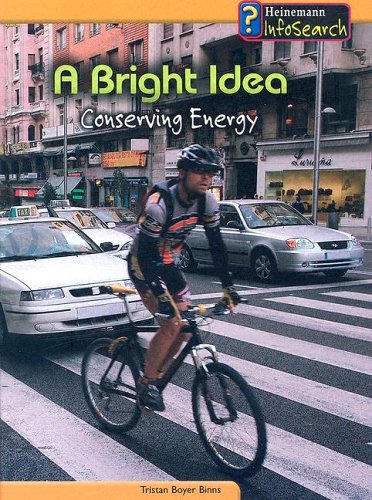-
Down the Drain: Conserving Water
Anita Ganeri, Chris Oxlade
Paperback (Heinemann, May 11, 2005)The many ways in which we use water – for drinking, washing in, cooking etc; vast amounts of water are also used in farming (it takes about 500 liters of water to produce one orange), industry, leisure and so on; Taking Action: keep a water diary to see how much water you use in 24 hours and what you use it for; why wasting water is a problem for the environment (danger of drought, water shortages); Science Behind It: why your body needs water to function S
S
-
The Great Outdoors: Saving Habitats
Richard Spilsbury
Paperback (Heinemann, May 11, 2005)All about wild places as habitats; how the plants and animals that live in a habitat are linked together; Science Behind It: food chains and webs; how smaller habitats are part of larger habitats e.g. a tree is part of a wood; how habitats form part of larger ecosystems. Taking Action: Make a simple map of the habitats in your neighborhood or around your school. W
W
-
Down the Drain: Conserving Water
Chris Oxlade, Anita Ganeri
Paperback (Heinemann Intl Inc, Aug. 30, 2005)This series tackles how to avoid creating unnecessary waste and the disposal of waste in environmentally acceptable ways. Focuses on how simple decisions have a knock-on effect for the whole planet. Uses case studies that look at success stories. Provides tips on how individuals can make a difference. Includes Science Behind It' boxes that explain scientific principles. S
S
-
Down the Drain: Conserving Water
Anita Ganeri, Chris Oxlade
Library Binding (Heinemann, May 11, 2005)The many ways in which we use water – for drinking, washing in, cooking etc; vast amounts of water are also used in farming (it takes about 500 liters of water to produce one orange), industry, leisure and so on; Taking Action: keep a water diary to see how much water you use in 24 hours and what you use it for; why wasting water is a problem for the environment (danger of drought, water shortages); Science Behind It: why your body needs water to function S
S
-
Something Old, Something New: Recycling
Anita Ganeri
Paperback (Heinemann, May 11, 2005)Waste is a big problem for our planet. We have to find places to put all the waste we throw away, and we are running out of space. Besides, every time we throw something away, we waste precious materials. Waste is bad for the environment. It can harm and kill plants and animals, including humans. X
X
-
Something Old, Something New: Recycling
Anita Ganeri
Library Binding (Heinemann, May 11, 2005)Ganeri, Anita N
N
-
Clean Planet: Stopping Litter and Pollution
Tristan Boyer Binns
Paperback (Heinemann, May 11, 2005)An introduction to the idea that we are constantly faced with pollution, visible such as litter and invisible such as contaminated drinking water. The idea that we cause most of the pollution in our world, that no one is “safe” from it, and that we can clean it up with effort. How children are proportionally more affected by pollution than adults. V
V
-
Great Outdoors: Saving Habitats
Richard Spilsbury
Paperback (Heinemann Intl Inc, Aug. 30, 2005)This series tackles how to avoid creating unnecessary waste and the disposal of waste in environmentally acceptable ways. Focuses on how simple decisions have a knock-on effect for the whole planet. Uses case studies that look at success stories. Provides tips on how individuals can make a difference. Includes Science Behind It' boxes that explain scientific principles. Q
Q
-
A Bright Idea: Conserving Energy
Tristan Boyer Binns
Paperback (Heinemann, May 11, 2005)An introduction to what energy is, in very general terms, how it comes from the sun and powers pretty much everything on Earth. The idea of energy as fuel that we use to power machines. Y
Y
-
A Bright Idea: Conserving Energy
Tristan Boyer Binns
Library Binding (Heinemann, May 11, 2005)Binns, Tristan Boyer Y
Y
-
Clean Planet: Stopping Litter and Pollution
Tristan Boyer Binns
Library Binding (Heinemann, May 11, 2005)An introduction to the idea that we are constantly faced with pollution, visible such as litter and invisible such as contaminated drinking water. The idea that we cause most of the pollution in our world, that no one is “safe” from it, and that we can clean it up with effort. How children are proportionally more affected by pollution than adults. V
V
-
Clean Planet: Stopping Litter and Pollution
Tristan Boyer Binns
Paperback (Heinemann Intl Inc, Aug. 30, 2005)How can you help save the planet? Using a child-centred approach, this series tackles how to avoid creating unnecessary waste and disposing of waste in environmentally acceptable ways. The series focuses on how simple decisions have a knock-on effect for the whole planet. It uses case studies that look at success stories; features 'Taking Action' boxes that provide tips on how individuals can make a difference; and includes 'Science Behind It' boxes that explain scientific principles. N
N